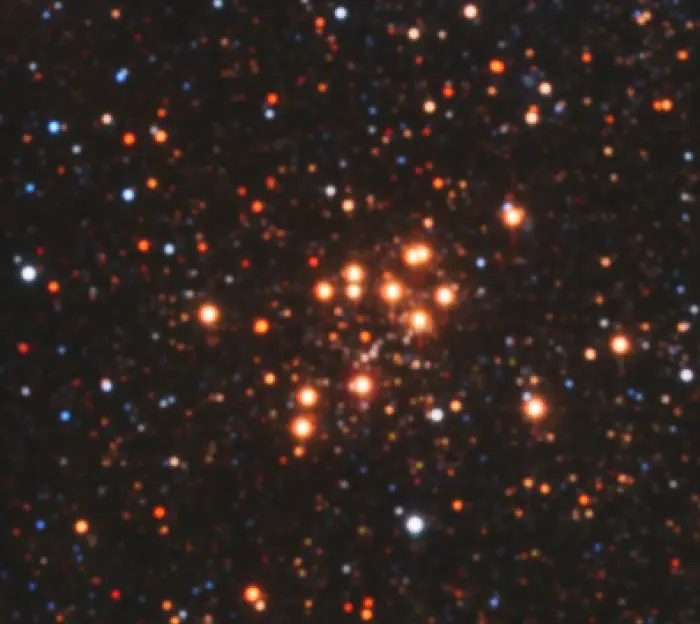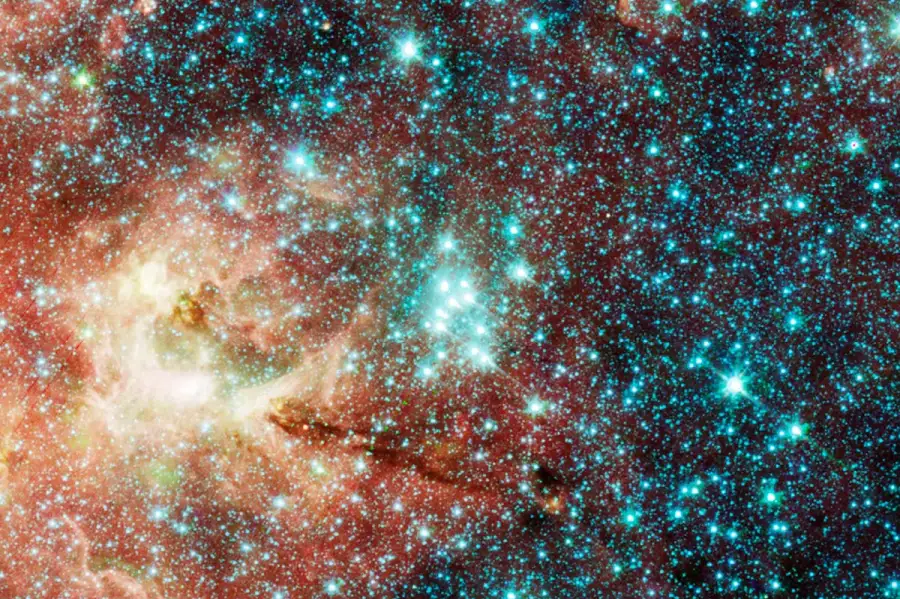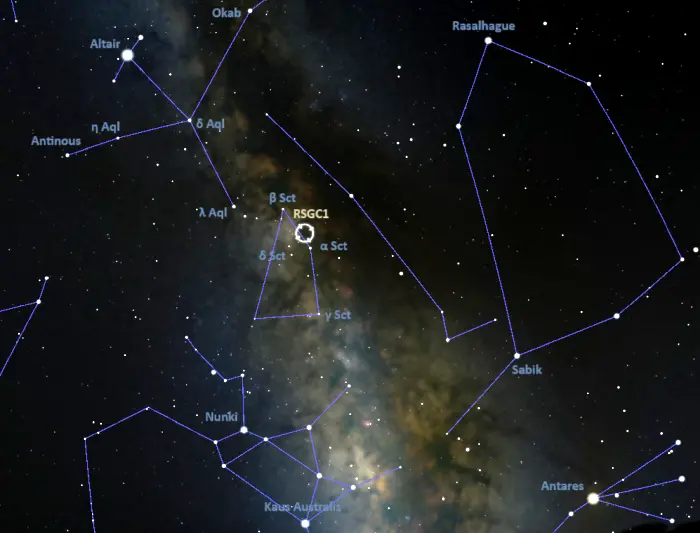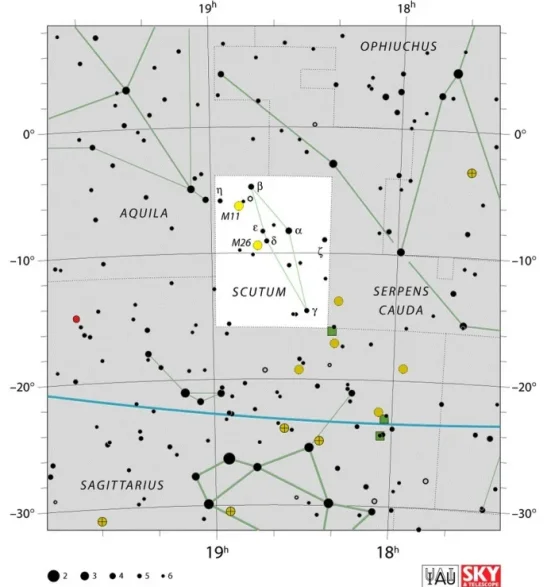RSGC1-F01 is a red supergiant star located approximately 22,000 light-years away in the constellation Scutum. With an estimated radius of 1,450 to 1,530 solar radii, it is one of the largest stars known. The supergiant is member of the massive young star cluster RSGC1. Discovered in 2006, the cluster and its members are invisible to the unaided eye and cannot be seen in optical telescopes.
Star type
RSGC1-F01 is a red supergiant with the spectral type M3/M5. With an effective temperature of 3,550 K, the star is 335,000 times more luminous than the Sun. It has an absolute magnitude of -11.75 and a K-band magnitude of 4.962. The massive red star is experiencing mass loss at a rate of 1.7 ± 0.5 × 10−5 solar masses per year.
The stellar parameters of RSGC1-F01 were derived based on observations with the Faint Object infraRed CAmera for the SOFIA Telescope (FORCAST) and the LMIRCam (LBT Mid-InfraRed interferometric Camera) on the Large Binocular Telescope (LBT). A team led by led by Roberta M. Humphreys of the Minnesota Institute for Astrophysics, University of Minnesota, Minneapolis, found a radius of 1,530 solar radii, making RSGC1-F01 one of the largest known stars in our Milky Way galaxy.

This false-color composite image of the cluster RSGC1 was captured by the Two Micron All Sky Survey (2MASS). Astronomers identified the cluster as a potential behemoth after spotting it in the 2MASS catalogue. They then used the Infrared Multi-object Spectrograph at the Kitt Peak National Observatory in Arizona to analyze the cluster’s colors. From that analysis, they discovered the red supergiants. They confirmed the red supergiants’ pedigree by studying the colors of other red supergiants in data taken by the Spitzer Space Telescope. Image credit: NASA/JPL-Caltech, D. Figer (STScI/RIT) (PD)
Size
RSGC1-F01 has an estimated radius between 1,450 and 1,530 times that of the Sun, which corresponds to a volume around 3.58 times greater than the Sun. The supergiant’s size was calculated using the Stefan-Boltzmann law. With a diameter this large, if RSGC1-F01 replaced the Sun at the center of the solar system, the star would engulf the orbits of Mercury, Venus, Earth and Mars, and extend beyond the orbit of Jupiter.
The radius of 1,530 solar radii was derived by Humphreys et al. in 2020 and the value of 1,450 solar radii comes from a 2023 study led by Leen Decin, Institute of Astronomy, KU Leuven, Belgium. The more recent study was based on observations with the Atacama Large Millimeter/submillimeter Array (ALMA). The scientists derived a surface temperature of 3,450 ± 127 K and a spectral type of M5 for RGSC1-F01.
The more recent radius estimate of 1,450 solar radii would make RSGC1-F01 similar in size to the one-time record holder VY Canis Majoris. Located in the constellation Canis Major, VY CMa has an estimated radius of 1,420 ± 120 R☉ and a mass about 17 times that of the Sun. Like other exceptionally massive stars, including RSGC1-F01, VY CMa is very young. It has an estimated age of 8.2 million years.
Based on the current estimates, RSGC1-F01 may be larger than the red supergiants CM Velorum in the constellation Vela (1,048 R☉– 1,416.24 R☉), AH Scorpii (1,411±124 R☉) in Scorpius, VX Sagittarii (1,360 R☉) in Sagittarius, NML Cygni (<1,350 R☉) in Cygnus, Stephenson 2-11 (1,300 R☉) and UY Scuti (909 R☉) in Scutum, and Mu Cephei (972 ± 228 R☉) in Cepheus. These are some of the Milky Way’s largest known stars.
The star’s Scutum neighbour Stephenson 2-18 still has a larger estimated radius than all these stars. However, a radius of 2,150 R☉ is much larger than stellar evolutionary models allow and is not considered a reliable estimate.
Outside our galaxy, the red supergiant HV 888 (WOH S140) in the Large Magellanic Cloud in the constellation Dorado has a larger estimated radius of 1,477 – 1,584 R☉. The previous record holder WOH G64 had an estimated radius of 1,540 R☉, but since the star transitioned into a yellow hypergiant, it shrunk to a radius of 800 R☉ in the past decade.
RSGC1-F01 is a member of the open star cluster RSGC1, one of the most massive young open clusters in the Milky Way.
RSGC1
The open cluster RSGC1 (Red Supergiant Cluster 1) has an apparent size of around 1.5 arcminutes, corresponding to a physical radius of about 1.5 parsecs (4.89 light-years). It has an estimated mass of 3 x 104 Suns (30,000 solar masses) and an age of only 12 ± 2 million years.
While it is one of the most massive open clusters in our galaxy, RSGC1 is still trailing behind the Ara Cluster (Westerlund 1), which has an estimated mass of 63,000 M☉. The only other open clusters that may have masses of more than 40,000 solar masses are the Central cluster, the Arches Cluster and the Quintuplet Cluster near the centre of the Milky Way.
RSGC1 contains about a dozen red supergiants with radii over 1,000 times that of the Sun. A total of 14 red supergiants have been identified in the cluster. Some of these stars have masses 16-20 times that of the Sun, which makes them supernova candidates. When they go out, they will collapse into neutron stars or black holes, depending on their initial mass. The young cluster also has more than 200 main sequence stars with masses of over 8 solar masses.
RSGC1 is believed to lie at the intersection of the Milky Way’s Scutum-Centaurus Arm (one of our galaxy’s major spiral arms) and the northern end of the galaxy’s Long Bar. The cluster lies near several other groupings of large red supergiant stars, including Stephenson 2 (RSGC2), RSGC3, RSGC4 (Alicante 8), RSGC5 (Alicante 7), and RSGC 6 (Alicante 10). Stephenson 2 is the home of Stephenson 2-18, possibly the largest star known.

The sky is a jewelry box full of sparkling stars in these infrared images. The crown jewels are 14 massive stars on the verge of going out as supernovae. These hefty stars reside in one of the most massive star clusters in the Milky Way Galaxy. The bluish cluster is inside the white box in the large image, which shows the star-studded region around it. These large stars are a tip-off to the mass of the young cluster. Astronomers estimate that the cluster is at least 20,000 times as massive as the Sun. Each red supergiant is about 20 times the Sun’s mass. The color-composite image was taken by the Spitzer Space Telescope for the Galactic Legacy Infrared Mid-Plane Survey Extraordinaire (GLIMPSE) Legacy project. The survey pierces through obscuring dust along the thick disk of our galaxy to reveal never-before-seen stars and star clusters. The false colors in the image correspond to infrared-light emission. The stars in the large color-composite image all appear blue because they emit most of their infrared light at shorter wavelengths. The science team that studied the star cluster consists of Don Figer, Space Telescope Science Institute/Rochester Institute of Techology; John MacKenty, Massimo Robberto, and Kester Smith, Space Telescope Science Institute; Francisco Najarro, Instituto de Estructura de la Materia in Madrid, Spain: Rolf Kudritzki, University of Hawaii in Honolulu; and Artemio Herrero, Universidad de La Laguna in Tenerife, Spain. Credit: NASA/JPL-Caltech, D. Figer (STScI/RIT) (PD)
Facts
RSGC1 was discovered by a team of astronomers led by Donald F. Figer of the Chester F. Carlson Center for Imaging Science, Rochester Institute of Technology, Rochester, New York, in 2006. The team analysed data obtained with the IRMOS (the near-Infrared Multi-Object Spectrograph), the Spitzer Space Telescope, and the 1.3m telescopes at the Fred Lawrence Whipple Observatory and the Cerro Tololo Inter-American Observatory in the Two Micron All-Sky Survey (2MASS). The astronomers identified 14 red supergiants and a “yellow” supergiant of spectral type G6 I in the cluster. The cluster was previously listed as candidate cluster 122 in a 2003 study by Dutra et al.
Figer et al. derived an initial cluster mass of 20,000 to 40,000 solar masses and an age of 7 to 12 million years and proposed that the cluster produced at least one supernova remnant similar to the Crab Nebula (Messier 1) in the constellation Taurus. The candidate remnant was catalogued as GPSR5 25.252-0.139. The study was published in The Astrophysical Journal in June 2006.
Name
RSGC1-F01 does not have a proper name approved by the International Astronomical Union (IAU). The designation RSCG1-F01 comes from the name of the star’s host cluster, the Red Supergiant Cluster 1. The cluster was named for the exceptional number of red supergiant members, greater than in any other open cluster detected to date.
Location
The open cluster RSGC1 lies in the faint constellation of Scutum (the Shield), which appears between the more prominent Aquila (the Eagle) and Sagittarius (the Archer). The cluster appears just west of the imaginary line connecting Alpha and Beta Scuti.

Location of the star cluster RSGC1, image: Stellarium
Constellation
RSGC1-F01 is located in the constellation Scutum (the Shield). Scutum is not one of the ancient constellations. It was created by the Polish astronomer Jan Heweliusz (Johannes Hevelius) in 1684 to commemorate the Polish King John III Sobieski and his triumph in the Battle of Vienna in 1683. The constellation was originally named Scutum Sobiescianum, meaning the Shield of Sobieski.
Scutum is one of the smallest constellations in the sky. Stretching across an area of only 109 square degrees, it is the 84th constellation in size out of 88. It lies just south of the celestial equator, between the larger and more prominent Aquila, Sagittarius, and Serpens.
Without any stars brighter than magnitude 3.0, Scutum is one of the fainter constellations. The constellation’s luminary, the orange giant Alpha Scuti, has an apparent magnitude of 3.83 and lies 199 light years away. Other stars in the constellation are fainter than magnitude 4.0. The visible ones include the yellow bright giants Beta and Epsilon Scuti, the orange giant Eta Scuti, the yellow giant Zeta Scuti, and the A-type dwarf Gamma Scuti.

Scutum constellation map by IAU and Sky&Telescope magazine (Roger Sinnott & Rick Fienberg) (CC BY 3.0)
The constellation is also home to Delta Scuti, a prototype for a class of variable stars known as the Delta Scuti variables, the post-AGB star AS 314, and the yellow supergiant R Scuti.
What it lacks in visual brightness, Scutum makes up in record-holding stars. The constellation contains some of the largest stars known in the Milky Way, including the red supergiants or hypergiants Stephenson 2-18 (RSGC2-01), Stephenson 2-11, UY Scuti, RSGC1-F06, RSGC1-F10, IRC −10414 (RAFGL 2139), RSGC1-F05, and RSGC1-F02. Most of these stars have radii over 1,000 times that of the Sun.
Deep sky objects in Scutum include the bright open clusters Messier 26 and the Wild Duck Cluster (Messier 11), the planetary nebulae M1-63 and IC 1295, and the globular cluster NGC 6712.
The best time of the year to observe the stars and deep sky objects in Scutum is during the month of August, when the constellation appears higher in the sky in the early evening. The entire constellation can be seen from locations south of the latitude 80° N, which is to say, from virtually any place on Earth.
The 10 brightest stars in Scutum are Alpha Scuti (mag. 3.83), Beta Scuti (mag. 4.22), Zeta Scuti (mag. 4.66), Gamma Scuti (mag. 4.67), Delta Scuti (mag. 4.60 – 4.79), Eta Scuti (mag. 4.83), Epsilon Scuti (mag. 4.88), HD 175156 (mag. 5.08), HD 171391 (mag. 5.12), and R Scuti (mag. 4.2 – 8.6).
RSGC1-F01
| Spectral class | M3/M5 |
| Apparent magnitude (K) | 4.962 |
| Absolute magnitude | -11.75 |
| Distance (RSGC1) | 22,000 ± 2,900 light-years (6.60 ± 0.89 kiloparecs) |
| Luminosity | 335,000 L☉ |
| Radius | 1,450 R☉; 1,530 R☉ (1,106 – 1,860 R☉) |
| Temperature | 3,550 K |
| Constellation | Scutum |
| Right ascension (RSGC1) | 18h 36m 29s |
| Declination (RSGC1) | −06° 52′ 48″ |
| Names and designations | RSGC1-F01, RSGC1-01 |